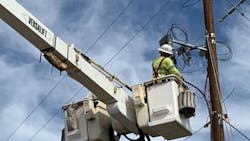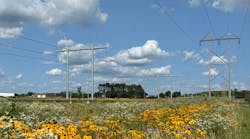Pinnacle West Leaders Raise Long-Term Sales Growth Forecast
Arizona’s strong economic growth is making for bright days at Pinnacle West Capital Corp., the parent of Arizona Public Service: The company’s executives on Nov. 3 said they are raising their long-term sales growth rate by a full percentage point to a range of 5% to 7%.
Chairman, President and CEO Ted Geisler and his team also are pushing that higher growth projection out to 2030. (Their previous forecast of sales growth between 4% and 6% had been through 2028.) Helping shape that outlook is 4.5 gigawatts of committed load that APS’ system is preparing to serve on top of the 8.6 GW at which the utility’s system peaked this year.
Speaking to analysts and investors on a conference call after his team reported third-quarter results, Geisler said that 4.5 GW will come from “a nice balance and blend” of industrial growth from chip manufacturers and data centers as well as consistent demand growth from homes and small businesses.
“I’d say that’s one of the hallmarks of our growth story. It’s a very diversified story, not too dependent on one industry or customer base or another,” Geisler said. “Maricopa County was just recently ranked top county for economic development in 2025 and it’s the third-fastest in the U.S., Phoenix just ranked No. 1 of the top 15 growth markets for manufacturing. And all of that is separate from a data center story. It just shows the true underlying growth.”
In the three months that ended Sept. 30, Pinnacle West’s overall weather-normalized sales growth came in at 5.4%. That comprised 6.6% growth from commercial and industrial customers as well as 4.3% residential growth. Since the beginning of 2024, weather-adjusted retail sales growth has averaged more than 5.3%.
Not surprisingly, that growth is pushing Geisler and his team to invest more: Planned capital spending from this year through the end of 2028 is expected to be nearly $10.4 billion compared to executives’ previous 2024-2027 forecast of $9.7 billion. Generation figures prominently: Among other things, the company has secured land for a new natural gas plant and during the third quarter committed $200 million to pick up its option for nearly 100 megawatts of capacity from its Palo Verde nuclear plant.
- About 120 miles of lines are in development and on track to be put in service by 2029
- Another nearly 70 miles will come online by 2032, outside of the company’s current capex forecast
- And more than 600 miles of extra-high voltage lines as well as lines to connect to the new gas plant are in various stages of the planning process
CFO Andrew Cooper told analysts that executives aren’t yet prepared to extend their growth forecasts, including annual rate base growth of 7% to 9%, beyond late this decade. But the number of longer-term projects not yet included in Pinnacle West’s current plans is a good sign.
“Our confidence is that that runway is quite long,” Cooper said.
Pinnacle West produced a net profit of nearly $418 million on operating revenues of $1.82 billion in the third quarter. Those figures were up from $399 million and $1.77 billion in the same period of last year and operating income rose more than 6% to $582 million.
Shares of Pinnacle West (Ticker: PNW) rose more than 2% to $89.45 after the company’s Q3 report and conference call. They are still down about 5% over the past six months, though, which has trimmed the company’s market capitalization to roughly $11 billion.
About the Author
Geert De Lombaerde
Senior Editor
A native of Belgium, Geert De Lombaerde has more than two decades of business journalism experience and writes about markets and economic trends for Endeavor Business Media publications T&D World, Healthcare Innovation, IndustryWeek, FleetOwner and Oil & Gas Journal. With a degree in journalism from the University of Missouri, he began his reporting career at the Business Courier in Cincinnati and later was managing editor and editor of the Nashville Business Journal. Most recently, he oversaw the online and print products of the Nashville Post and reported primarily on Middle Tennessee’s finance sector as well as many of its publicly traded companies.



